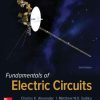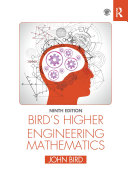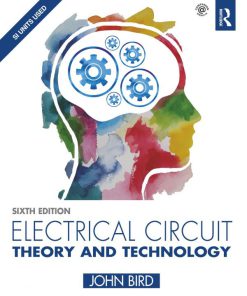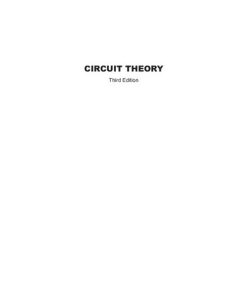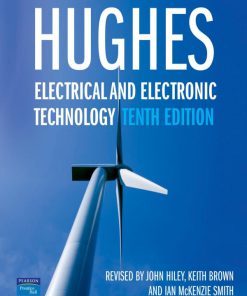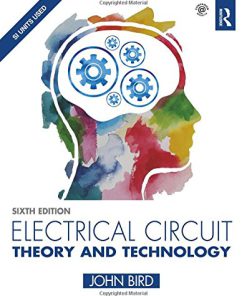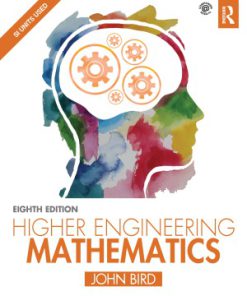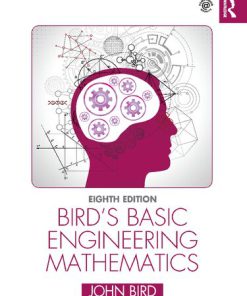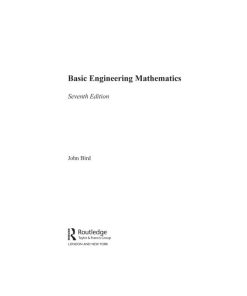Electrical Circuit Theory and Technology 6th Edition by Bird John ISBN 1317202805 9781317202806
$50.00 Original price was: $50.00.$25.00Current price is: $25.00.
Electrical Circuit Theory and Technology 6th Edition by Bird John – Ebook PDF Instant Download/Delivery: 1317202805, 9781317202806
Full download Electrical Circuit Theory and Technology 6th Edition after payment
Product details:
ISBN 10: 1317202805
ISBN 13: 9781317202806
Author: Bird John
A fully comprehensive text for courses in electrical principles, circuit theory and electrical technology, providing 800 worked examples and over 1,350 further problems for students to work through at their own pace. This book is ideal for students studying engineering for the first time as part of BTEC National and other pre-degree vocational courses, as well as Higher Nationals, Foundation Degrees and first-year undergraduate modules.
Electrical Circuit Theory and Technology 6th Table of contents:
Part 1 Revision of some basic mathematics
1 Some mathematics revision
1.1 Use of calculator and evaluating formulae
1.2 Fractions
1.3 Percentages
1.4 Ratio and proportion
1.5 Laws of indices
1.6 Brackets
1.7 Solving simple equations
1.8 Transposing formulae
1.9 Solving simultaneous equations
2 Further mathematics revision
2.1 Radians and degrees
2.2 Measurement of angles
2.3 Trigonometry revision
2.4 Logarithms and exponentials
2.5 Straight line graphs
2.6 Gradients, intercepts and equation of a graph
2.7 Practical straight line graphs
2.8 Calculating areas of common shapes
Main formulae for Part 1 Revision of some basic mathematics
Part 2 Basic electrical engineering principles
3 Units associated with basic electrical quantities
3.1 SI units
3.2 Charge
3.3 Force
3.4 Work
3.5 Power
3.6 Electrical potential and e.m.f.
3.7 Resistance and conductance
3.8 Electrical power and energy
3.9 Summary of terms, units and their symbols
4 An introduction to electric circuits
4.1 Standard symbols for electrical components
4.2 Electric current and quantity of electricity
4.3 Potential difference and resistance
4.4 Basic electrical measuring instruments
4.5 Linear and non-linear devices
4.6 Ohm’s law
4.7 Multiples and sub-multiples
4.8 Conductors and insulators
4.9 Electrical power and energy
4.10 Main effects of electric current
4.11 Fuses
4.12 Insulation and the dangers of constant high current flow
5 Resistance variation
5.1 Resistor construction
5.2 Resistance and resistivity
5.3 Temperature coefficient of resistance
5.4 Resistor colour coding and ohmic values
6 Batteries and alternative sources of energy
6.1 Introduction to batteries
6.2 Some chemical effects of electricity
6.3 The simple cell
6.4 Corrosion
6.5 E.m.f. and internal resistance of a cell
6.6 Primary cells
6.7 Secondary cells
6.8 Lithium-ion batteries
6.9 Cell capacity
6.10 Safe disposal of batteries
6.11 Fuel cells
6.12 Alternative and renewable energy sources
6.13 Solar energy
Revision Test 1
7 Series and parallel networks
7.1 Series circuits
7.2 Potential divider
7.3 Parallel networks
7.4 Current division
7.5 Loading effect
7.6 Potentiometers and rheostats
7.7 Relative and absolute voltages
7.8 Earth potential and short circuits
7.9 Wiring lamps in series and in parallel
8 Capacitors and capacitance
8.1 Introduction to capacitors
8.2 Electrostatic field
8.3 Electric field strength
8.4 Capacitance
8.5 Capacitors
8.6 Electric flux density
8.7 Permittivity
8.8 The parallel plate capacitor
8.9 Capacitors connected in parallel and series
8.10 Dielectric strength
8.11 Energy stored
8.12 Practical types of capacitor
8.13 Supercapacitors
8.14 Discharging capacitors
9 Magnetic circuits
9.1 Introduction to magnetism and magnetic circuits
9.2 Magnetic fields
9.3 Magnetic flux and flux density
9.4 Magnetomotive force and magnetic field strength
9.5 Permeability and B-H curves
9.6 Reluctance
9.7 Composite series magnetic circuits
9.8 Comparison between electrical and magnetic quantities
9.9 Hysteresis and hysteresis loss
Revision Test 2
10 Electromagnetism
10.1 Magnetic field due to an electric current
10.2 Electromagnets
10.3 Force on a current-carrying conductor
10.4 Principle of operation of a simple d.c. motor
10.5 Principle of operation of a moving-coil instrument
10.6 Force on a charge
11 Electromagnetic induction
11.1 Introduction to electromagnetic induction
11.2 Laws of electromagnetic induction
11.3 Rotation of a loop in a magnetic field
11.4 Inductance
11.5 Inductors
11.6 Energy stored
11.7 Inductance of a coil
11.8 Mutual inductance
12 Electrical measuring instruments and measurements
12.1 Introduction
12.2 Analogue instruments
12.3 Shunts and multipliers
12.4 Electronic instruments
12.5 The ohmmeter
12.6 Multimeters
12.7 Wattmeters
12.8 Instrument ‘loading’ effect
12.9 The oscilloscope
12.10 Virtual test and measuring instruments
12.11 Virtual digital storage oscilloscopes
12.12 Waveform harmonics
12.13 Logarithmic ratios
12.14 Null method of measurement
12.15 Wheatstone bridge
12.16 D.c. potentiometer
12.17 A.c. bridges
12.18 Measurement errors
13 Semiconductor diodes
13.1 Types of material
13.2 Semiconductor materials
13.3 Conduction in semiconductor materials
13.4 The p-n junction
13.5 Forward and reverse bias
13.6 Semiconductor diodes
13.7 Characteristics and maximum ratings
13.8 Rectification
13.9 Zener diodes
13.10 Silicon controlled rectifiers
13.11 Light emitting diodes
13.12 Varactor diodes
13.13 Schottky diodes
14 Transistors
14.1 Transistor classification
14.2 Bipolar junction transistors (BJTs)
14.3 Transistor action
14.4 Leakage current
14.5 Bias and current flow
14.6 Transistor operating configurations
14.7 Bipolar transistor characteristics
14.8 Transistor parameters
14.9 Current gain
14.10 Typical BJT characteristics and maximum ratings
14.11 Field effect transistors
14.12 Field effect transistor characteristics
14.13 Typical FET characteristics and maximum ratings
14.14 Transistor amplifiers
14.15 Load lines
Revision Test 3
Main formulae for Part 2 Basic electrical and electronic principles
Part 3 Electrical principles and technology
15 D.c. circuit theory
15.1 Introduction
15.2 Kirchhoff’s laws
15.3 The superposition theorem
15.4 General d.c. circuit theory
15.5 Thévenin’s theorem
15.6 Constant-current source
15.7 Norton’s theorem
15.8 Thévenin and Norton equivalent networks
15.9 Maximum power transfer theorem
16 Alternating voltages and currents
16.1 Introduction
16.2 The a.c. generator
16.3 Waveforms
16.4 A.c. values
16.5 Electrical safety – insulation and fuses
16.6 The equation of a sinusoidal waveform
16.7 Combination of waveforms
16.8 Rectification
16.9 Smoothing of the rectified output waveform
Revision Test 4
17 Single-phase series a.c. circuits
17.1 Purely resistive a.c. circuit
17.2 Purely inductive a.c. circuit
17.3 Purely capacitive a.c. circuit
17.4 R-L series a.c. circuit
17.5 R-C series a.c. circuit
17.6 R-L-C series a.c. circuit
17.7 Series resonance
17.8 Q-factor
17.9 Bandwidth and selectivity
17.10 Power in a.c. circuits
17.11 Power triangle and power factor
18 Single-phase parallel a.c. circuits
18.1 Introduction
18.2 R-L parallel a.c. circuit
18.3 R-C parallel a.c. circuit
18.4 L-C parallel a.c. circuit
18.5 LR-C parallel a.c. circuit
18.6 Parallel resonance and Q-factor
18.7 Power factor improvement
19 D.c. transients
19.1 Introduction
19.2 Charging a capacitor
19.3 Time constant for a C-R circuit
19.4 Transient curves for a C-R circuit
19.5 Discharging a capacitor
19.6 Camera flash
19.7 Current growth in an L-R circuit
19.8 Time constant for an L-R circuit
19.9 Transient curves for an L-R circuit
19.10 Current decay in an L-R circuit
19.11 Switching inductive circuits
19.12 The effect of time constant on a rectangular waveform
20 Operational amplifiers
20.1 Introduction to operational amplifiers
20.2 Some op amp parameters
20.3 Op amp inverting amplifier
20.4 Op amp non-inverting amplifier
20.5 Op amp voltage-follower
20.6 Op amp summing amplifier
20.7 Op amp voltage comparator
20.8 Op amp integrator
20.9 Op amp differential amplifier
20.10 Digital to analogue (D/A) conversion
20.11 Analogue to digital (A/D) conversion
Revision Test 5
21 Ways of generating electricity – the present and the future
21.1 Introduction
21.2 Generating electrical power using coal
21.3 Generating electrical power using oil
21.4 Generating electrical power using natural gas
21.5 Generating electrical power using nuclear energy
21.6 Generating electrical power using hydro power
21.7 Generating electrical power using pumped storage
21.8 Generating electrical power using wind
21.9 Generating electrical power using tidal power
21.10 Generating electrical power using biomass
21.11 Generating electrical power using solar energy
21.12 Harnessing the power of wind, tide and sun on an ‘energy island’ – a future possibility?
22 Three-phase systems
22.1 Introduction
22.2 Three-phase supply
22.3 Star connection
22.4 Delta connection
22.5 Power in three-phase systems
22.6 Measurement of power in three-phase systems
22.7 Comparison of star and delta connections
22.8 Advantages of three-phase systems
23 Transformers
23.1 Introduction
23.2 Transformer principle of operation
23.3 Transformer no-load phasor diagram
23.4 E.m.f. equation of a transformer
23.5 Transformer on-load phasor diagram
23.6 Transformer construction
23.7 Equivalent circuit of a transformer
23.8 Regulation of a transformer
23.9 Transformer losses and efficiency
23.10 Resistance matching
23.11 Auto transformers
23.12 Isolating transformers
23.13 Three-phase transformers
23.14 Current transformers
23.15 Voltage transformers
Revision Test 6
24 D.c. machines
24.1 Introduction
24.2 The action of a commutator
24.3 D.c. machine construction
24.4 Shunt, series and compound windings
24.5 E.m.f. generated in an armature winding
24.6 D.c. generators
24.7 Types of d.c. generator and their characteristics
24.8 D.c. machine losses
24.9 Efficiency of a d.c. generator
24.10 D.c. motors
24.11 Torque of a d.c. machine
24.12 Types of d.c. motor and their characteristics
24.13 The efficiency of a d.c. motor
24.14 D.c. motor starter
24.15 Speed control of d.c. motors
24.16 Motor cooling
25 Three-phase induction motors
25.1 Introduction
25.2 Production of a rotating magnetic field
25.3 Synchronous speed
25.4 Construction of a three-phase induction motor
25.5 Principle of operation of a three-phase induction motor
25.6 Slip
25.7 Rotor e.m.f. and frequency
25.8 Rotor impedance and current
25.9 Rotor copper loss
25.10 Induction motor losses and efficiency
25.11 Torque equation for an induction motor
25.12 Induction motor torque-speed characteristics
25.13 Starting methods for induction motors
25.14 Advantages of squirrel-cage induction motors
25.15 Advantages of wound rotor induction motor
25.16 Double cage induction motor
25.17 Uses of three-phase induction motors
Revision Test 7
Main formulae for Part 3 Electrical principles and technology
Part 4 Advanced circuit theory and technology
26 Revision of complex numbers
26.1 Introduction
26.2 Operations involving Cartesian complex numbers
26.3 Complex equations
26.4 The polar form of a complex number
26.5 Multiplication and division using complex numbers in polar form
26.6 De Moivre’s theorem – powers and roots of complex numbers
27 Application of complex numbers to series a.c. circuits
27.1 Introduction
27.2 Series a.c. circuits
27.3 Further worked problems on series a.c. circuits
28 Application of complex numbers to parallel a.c. networks
28.1 Introduction
28.2 Admittance, conductance and susceptance
28.3 Parallel a.c. networks
28.4 Further worked problems on parallel a.c. networks
29 Power in a.c. circuits
29.1 Introduction
29.2 Determination of power in a.c. circuits
29.3 Power triangle and power factor
29.4 Use of complex numbers for determination of power
29.5 Power factor improvement
Revision Test 8
30 A.c. bridges
30.1 Introduction
30.2 Balance conditions for an a.c. bridge
30.3 Types of a.c. bridge circuit
30.4 Worked problems on a.c. bridges
31 Series resonance and Q-factor
31.1 Introduction
31.2 Series resonance
31.3 Q-factor
31.4 Voltage magnification
31.5 Q-factors in series
31.6 Bandwidth
31.7 Small deviations from the resonant frequency
32 Parallel resonance and Q-factor
32.1 Introduction
32.2 The LR-C parallel network
32.3 Dynamic resistance
32.4 The LR-CR parallel network
32.5 Q-factor in a parallel network
32.6 Further worked problems on parallel resonance and Q-factor
Revision Test 9
33 Introduction to network analysis
33.1 Introduction
33.2 Solution of simultaneous equations using determinants
33.3 Network analysis using Kirchhoff’s laws
34 Mesh-current and nodal analysis
34.1 Mesh-current analysis
34.2 Nodal analysis
35 The superposition theorem
35.1 Introduction
35.2 Using the superposition theorem
35.3 Further worked problems on the superposition theorem
36 Thévenin’s and Norton’s theorems
36.1 Introduction
36.2 Thévenin’s theorem
36.3 Further worked problems on Thévenin’s theorem
36.4 Norton’s theorem
36.5 Thévenin and Norton equivalent networks
Revision Test 10
37 Delta-star and star-delta transformations
37.1 Introduction
37.2 Delta and star connections
37.3 Delta-star transformation
37.4 Star-delta transformation
38 Maximum power transfer theorems and impedance matching
38.1 Maximum power transfer theorems
38.2 Impedance matching
Revision Test 11
39 Complex waveforms
39.1 Introduction
39.2 The general equation for a complex waveform
39.3 Harmonic synthesis
39.4 Fourier series of periodic and non-periodic functions
39.5 Even and odd functions and Fourier series over any range
39.6 R.m.s. value, mean value and the form factor of a complex wave
39.7 Power associated with complex waves
39.8 Harmonics in single-phase circuits
39.9 Further worked problems on harmonics in single-phase circuits
39.10 Resonance due to harmonics
39.11 Sources of harmonics
40 A numerical method of harmonic analysis
40.1 Introduction
40.2 Harmonic analysis on data given in tabular or graphical form
40.3 Complex waveform considerations
41 Magnetic materials
41.1 Revision of terms and units used with magnetic circuits
41.2 Magnetic properties of materials
41.3 Hysteresis and hysteresis loss
41.4 Eddy current loss
41.5 Separation of hysteresis and eddy current losses
41.6 Non-permanent magnetic materials
41.7 Permanent magnetic materials
Revision Test 12
42 Dielectrics and dielectric loss
42.1 Electric fields, capacitance and permittivity
42.2 Polarization
42.3 Dielectric strength
42.4 Thermal effects
42.5 Mechanical properties
42.6 Types of practical capacitor
42.7 Liquid dielectrics and gas insulation
42.8 Dielectric loss and loss angle
43 Field theory
43.1 Field plotting by curvilinear squares
43.2 Capacitance between concentric cylinders
43.3 Capacitance of an isolated twin line
43.4 Energy stored in an electric field
43.5 Induced e.m.f. and inductance
43.6 Inductance of a concentric cylinder (or coaxial cable)
43.7 Inductance of an isolated twin line
43.8 Energy stored in an electromagnetic field
44 Attenuators
44.1 Introduction
44.2 Characteristic impedance
44.3 Logarithmic ratios
44.4 Symmetrical T- and π-attenuators
44.5 Insertion loss
44.6 Asymmetrical T- and π-sections
44.7 The L-section attenuator
44.8 Two-port networks in cascade
44.9 ABCD parameters
44.10 ABCD parameters for networks
44.11 Characteristic impedance in terms of ABCD parameters
Revision Test 13
45 Filter networks
45.1 Introduction
45.2 Basic types of filter sections
45.3 The characteristic impedance and the attenuation of filter sections
45.4 Ladder networks
45.5 Low-pass filter sections
45.6 High-pass filter sections
45.7 Propagation coefficient and time delay in filter sections
45.8 ‘m-derived’ filter sections
45.9 Practical composite filters
46 Magnetically coupled circuits
46.1 Introduction
46.2 Self-inductance
46.3 Mutual inductance
46.4 Coupling coefficient
46.5 Coils connected in series
46.6 Coupled circuits
46.7 Dot rule for coupled circuits
47 Transmission lines
47.1 Introduction
47.2 Transmission line primary constants
47.3 Phase delay, wavelength and velocity of propagation
47.4 Current and voltage relationships
47.5 Characteristic impedance and propagation coefficient in terms of the primary constants
47.6 Distortion on transmission lines
47.7 Wave reflection and the reflection coefficient
47.8 Standing-waves and the standing-wave ratio
48 Transients and Laplace transforms
48.1 Introduction
48.2 Response of R-C series circuit to a step input
48.3 Response of R-L series circuit to a step input
48.4 L-R-C series circuit response
48.5 Introduction to Laplace transforms
48.6 Inverse Laplace transforms and the solution of differential equations
48.7 Laplace transform analysis directly from the circuit diagram
48.8 L-R-C series circuit using Laplace transforms
48.9 Initial conditions
Revision Test 14
Main formulae for Part 4 Advanced circuit theory and technology
Part 5 General reference
Standard electrical quantities – their symbols and units
Greek alphabet
Common prefixes
Resistor colour coding and ohmic values
People also search for Electrical Circuit Theory and Technology 6th:
bird’s electrical circuit theory and technology
bird’s electrical circuit theory and technology 7th edition
john bird electrical circuit theory and technology 5th edition
bird’s electrical circuit theory and technology 7th edition pdf download
bird j 2013 electrical circuit theory and technology routledge
Tags:
Bird John,Electrical Circuit,Theory,Technology
You may also like…
Mathematics - Applied Mathematics
Engineering
Electrical Circuit Theory and Technology 6th Edition by John Bird 1317202806 9781317202806
Engineering - Electrical & Electronic Engineering
Circuit Theory 3rd Edition by Nagoor Kani 9339224752 9789339224752
Housekeeping & Leisure - Interior Design & Decoration
ELECTRICAL AND ELECTRONIC TECHNOLOGY, TENTH EDITION REVISED John Hiley
Engineering - Electrical & Electronic Engineering
Electrical Circuit Theory and Technology 6th Edition by Bird John ISBN 1317202805 9781317202806
Uncategorized
Mathematics - Applied Mathematics



